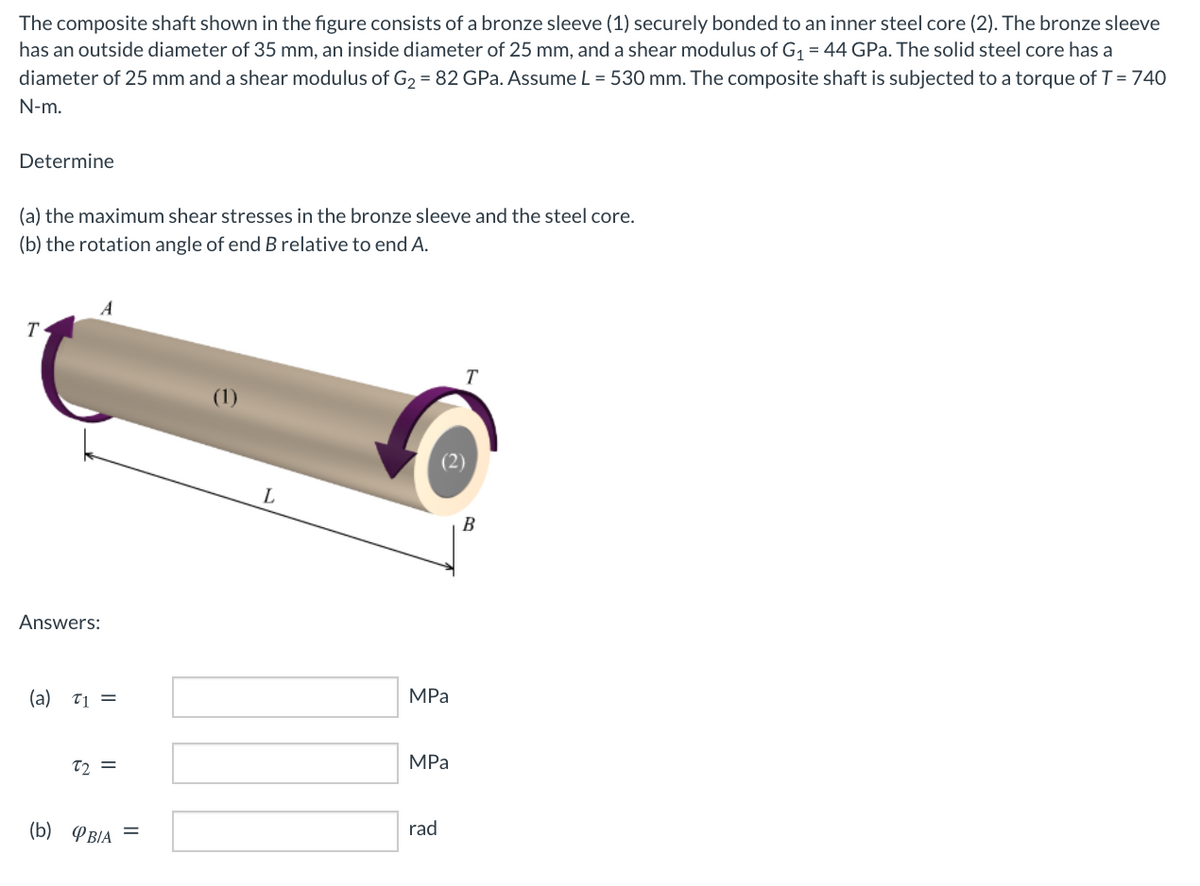The composite shaft shown in the figure consists of a bronze sleeve (1) securely bonded to an inner steel core (2). The bronze sleeve has an outside diameter of 35 mm, an inside diameter of 25 mm, and a shear modulus of G1 = 44 GPa. The solid steel core has a diameter of 25 mm and a shear modulus of G2 = 82 GPa. Assume L = 530 mm. The composite shaft is subjected to a torque of T = 740 N-m. Determine (a) the maximum shear stresses in the bronze sleeve and the steel core. (b) the rotation angle of end B relative to end A. T T (1) (2) B Answers: (a) T1 = MPa T2 = MPa (b) PBIA = rad
The composite shaft shown in the figure consists of a bronze sleeve (1) securely bonded to an inner steel core (2). The bronze sleeve has an outside diameter of 35 mm, an inside diameter of 25 mm, and a shear modulus of G1 = 44 GPa. The solid steel core has a diameter of 25 mm and a shear modulus of G2 = 82 GPa. Assume L = 530 mm. The composite shaft is subjected to a torque of T = 740 N-m. Determine (a) the maximum shear stresses in the bronze sleeve and the steel core. (b) the rotation angle of end B relative to end A. T T (1) (2) B Answers: (a) T1 = MPa T2 = MPa (b) PBIA = rad
Mechanics of Materials (MindTap Course List)
9th Edition
ISBN:9781337093347
Author:Barry J. Goodno, James M. Gere
Publisher:Barry J. Goodno, James M. Gere
Chapter3: Torsion
Section: Chapter Questions
Problem 3.7.10P: What is the maximum power that can be delivered by a hollow propeller shaft (outside diameter 50 mm,...
Related questions
Question

Transcribed Image Text:The composite shaft shown in the figure consists of a bronze sleeve (1) securely bonded to an inner steel core (2). The bronze sleeve
has an outside diameter of 35 mm, an inside diameter of 25 mm, and a shear modulus of G1 = 44 GPa. The solid steel core has a
diameter of 25 mm and a shear modulus of G2 = 82 GPa. Assume L = 530 mm. The composite shaft is subjected to a torque of T = 740
N-m.
Determine
(a) the maximum shear stresses in the bronze sleeve and the steel core.
(b) the rotation angle of end B relative to end A.
T.
T
(1)
L
B
Answers:
MPa
(a) T1 =
MPa
T2 =
rad
(b) PBIA
Expert Solution
This question has been solved!
Explore an expertly crafted, step-by-step solution for a thorough understanding of key concepts.
This is a popular solution!
Trending now
This is a popular solution!
Step by step
Solved in 3 steps with 2 images

Knowledge Booster
Learn more about
Need a deep-dive on the concept behind this application? Look no further. Learn more about this topic, mechanical-engineering and related others by exploring similar questions and additional content below.Recommended textbooks for you

Mechanics of Materials (MindTap Course List)
Mechanical Engineering
ISBN:
9781337093347
Author:
Barry J. Goodno, James M. Gere
Publisher:
Cengage Learning

Mechanics of Materials (MindTap Course List)
Mechanical Engineering
ISBN:
9781337093347
Author:
Barry J. Goodno, James M. Gere
Publisher:
Cengage Learning